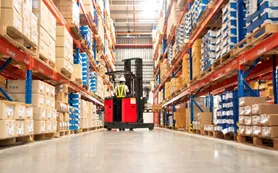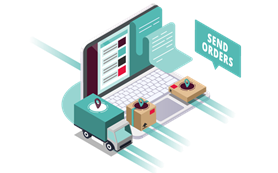
Is it time to switch order management systems? Look for these 5 signs.
If you are reading this article, it is likely your order management system (OMS) is struggling to keep up with the demands of your ecommerce or third-party logistics (3PL) business.
A few years ago, your current solution was probably more than sufficient. But as your business has grown, along with customer expectations and order volumes, the limitations of your order management software have become glaringly apparent.
Here, we outline five of the most common signs that it may be time to upgrade to a more efficient, scalable and feature-rich order management system.
 4 mins
4 mins
Written by The Access Group
1. You’re weighed down by manual processes
If your order management system leaves your team burdened with manual processes like entering figures into spreadsheets or creating delivery labels and invoices, it is a good indication you need to make a change. The marker of a good OMS is that it can automate the majority of these tasks, including:
- Gathering order information from your shopping carts and ecommerce platforms
- Coordinating the shipping process for each individual order
- Monitoring expenses like delivery charges to be billed to customers
- Generating order pick lists for your fulfilment team
- Notifying customers about their orders, including tracking details
2. You can’t manage shopping carts and marketplaces
The best order management systems offer integration with the third-party platforms ecommerce businesses and 3PLs need most. This includes leading marketplaces like Amazon, Wish, eBay, Wayfair and OnBuy, as well as shopping carts like Shopify, Magento, Bluepark and X-Cart.
But not only do modern order management software offer integration with marketplaces and shopping carts, they centralise them in one platform, giving you full control and visibility of orders across all your sales channels.
Having all third-party platform data unified in one system simplifies the handling of orders, inventory management, shipments and accounting. Such order management systems can also automate manual tasks typically required with marketplaces and shopping carts with multichannel listing software, and offer data management capabilities to analyse trends and product statistics.
3. Unintegrated systems are a challenge
Does your order management system lack integration with your accounting software? Are you managing your warehouse and inventory with separate solutions? The best order management systems allow you to integrate all these solutions to save time and simplify processes.
This eliminates the need to manually transfer data between solutions when undertaking tasks like invoicing customers or updating your warehouse inventory levels. Modern order management systems also offer courier management software which integrates with leading couriers and multi-carriers, with some able to automatically select services based on criteria you define.
4. Your order management system is becoming outdated
Order management systems must be constantly improved by software providers to ensure they not only keep up with increasing customer demands, but also the evolving technology landscape. As marketplaces add new capabilities, you definitely want your OMS to be sufficiently advanced to take advantage of them.
A good example of this is Fulfilled by Amazon (FBA), which allows you to outsource your business’s order fulfilment to Amazon. You can house your stock in Amazon’s warehouses, with the company taking care of packing and delivering of orders, while also providing customer support and managing order returns.
Services like FBA can help you deliver items faster, save time and reduce costs, and they are constantly being rolled out by marketplaces. Leading OMS offer full integration with these services and provide features to simplify the management of multiple marketplaces, automate manual tasks and meet their compliance standards.
5. You’re outgrowing your order management system
In 2022, online sales accounted for 18.1 per cent of total retail spend in Australia, with one million more households buying online compared to three years earlier. By 2023, one in three retail dollars are projected to be spent online.[1]
If you are an online retailer that is starting to face challenges meeting order demands, or as a 3PL, the needs of ecommerce clients, how will your order management system fare as these demands only increase in the coming years?
Making the switch to a more robust and efficient platform – one that scales and adapts with your growing business – might be something better done sooner than later. Upgrading prior to outgrowing the limits of your existing system means you won’t experience an interim period of substandard service that can ruin customer loyalty. This more than makes up for the time and cost investment required to switch order management software.
[1] Australia Post, 2023 eCommerce Industry Report: Inside Australian Online Shopping
Have you thought about switching to a cloud-based order management system?
If you are leaning toward switching order management systems, it might make most sense to consider a cloud-based solution. Why? You can access a cloud-based system from wherever you are, as long as you have an internet connection. This removes the need for costly local servers or networks, as all your data is stored in the cloud with word-class security, while software updates are automatically provided by your software vendor.
Simplify fulfilment with Access Mintsoft
Access Mintsoft is a cloud-based order management system designed to solve the challenges of online retailers and 3PLs. It helps over 700 businesses worldwide streamline order fulfillment, reduce costs and stay ahead of the increasing demands of ecommerce selling.
The solution offers integration with leading shopping carts, marketplaces and couriers, as well as inventory management and warehouse management features, all in one intuitive platform. With Access Mintsoft, you can automate manual processes to enhance picking, packing and shopping while also having real-time visibility of all your fulfilment processes.
CASE STUDY | A business benefiting from WMS systems
Black Bear Fulfillment have a simple mission: To provide the high levels of fulfillment service to Australian customers, which they experienced as a former eCommerce seller in the US and UK. An eCommerce 3PL specialising in smaller consumer items, such as clothing and cosmetics, Black Bear Fulfillment are 100% Australian owned and operated. They are based in Melbourne and employ more than 40 people after launching just three years ago.
Unlike most 3PL’s they aren’t just focused on the logistics and warehousing side of the business, but also, importantly, the customer. Fulfillment is about people as much as it is logistics, and they needed a software solution to help bring this customer-centric vision to life.
 Case Study
Case Study
Read the Black Bear Fulfillment case study to learn more about how this Australian 3PL has leveraged the power of the Mintsoft solution to grow their business and deliver a world-class customer experience.
Book your free demo or download our brochure today to discover how Access Mintsoft can help your 3PL, warehouse or a ecommerce business save time, reduce costs and stand out from the competition.
Want to know more?
Have a read through more order management resources, guidance and advice.




